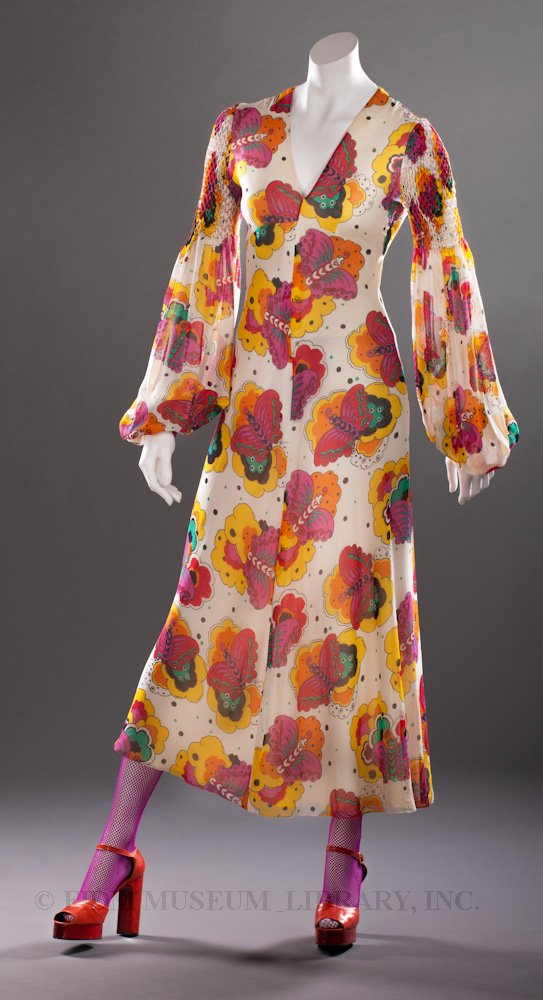Thea Porter butterfly print dress
Want to see this vibrant Thea Porter dress in person?
Make a beeline for the MFA Boston, where it's currently on display in Hippie Chic, an exhibit celebrating the fashions of the Woodstock generation. On view through November 11, 2013, Hippie Chic features 54 ensembles, including seven garments borrowed from the FIDM Museum collection. Curator Kevin Jones travelled to Boston to dress and install the FIDM Museum garments, as described in his recent blog post Vamps & Hippies.

Thea Porter
c. 1970-1972
Printed polyester chiffon
Gift of Anonymous Donor
82.40.1
Thea Porter's (1927-2000) designs embodied the "rich hippie" look of the late 1960s. In the words of one fashion watcher, "she taught the rich how to look hip and Halston how to cash in on caftans."1 Born in Jerusalem to missionary parents, Porter was raised in Damascus, Syria. After marrying a British diplomat in 1953, Porter lived for nearly a decade in Lebanon. After separating from her husband in 1964, Porter moved to London and worked as an interior designer. By 1967, Porter had established Thea Porter Decorations Ltd. in London's Soho district.
In her interior design schemes, Porter often worked with a trove of antique caftans collected during her years living in the Middle East. At the same time, trendsetters were beginning to look outside Europe and America for fashion inspiration. Clients who admired the luxe, non-western textiles Porter used in their homes began asking if these same textiles could be made into garments. Thus, Porter transitioned from interior designer to fashion designer. As Porter said in a 1970 interview, "I just drifted into [making] clothes."2
The exoticism of Porter's early designs fit the mood of the era and Porter soon had a clientele that included Faye Dunaway, Talitha Getty, Jane Holzer, Britt Eklund, Elizabeth Taylor, and other jet-setting celebrities. Clients could choose from a limited selection of ready-to-wear garments, or work with the designer to create unique one of a kind pieces. In the words of 1960s style icon Jane Holzer, wearing a Thea Porter garment offered a unique experience: “It’s like wearing a king’s raiment.”3
In 1971, Porter opened a boutique in New York. Her designs also retailed at a variety of high-end department stores and boutiques throughout North America. Her aesthetic moved away from the voluminous caftans of the late 1960s and towards a nostalgic interpretation of the 1930s and 1940s. Porter credited this transition to an "awful nostalgia for old films."4 This shift is evident in the silhouette of Porter's butterfly print dress, which plays with two features of 1930s dress: a bias-cut skirt and unusual sleeves.
Chiffon, used in the dress pictured above, was one of Porter's favorite textiles. The fabric's filmy, lightweight texture suited the romantic, exotic mood of Porter's designs. Here, off-white chiffon is printed with a colorful, almost psychedelic, pattern of butterflies hovering over clouds or flowers. Billowy bishop sleeves are given definition with intricate shoulder smocking. Though Porter sometimes designed unlined, see-through chiffon caftans and tunics, this dress is completely lined.
1 Luther, Marylou. "Britain as a Land of Fashion Enchantment." Los Angeles Times (May 9, 1973), I1.
2 Morris, Bernadine. "Fashions Designed with Nostalgic Look." New York Times (Oct 12, 1970), 65.
3 "Vogue's Own Boutique: Everybody's Talking" Vogue (Nov 15, 1968), 192.
4 Ibid.